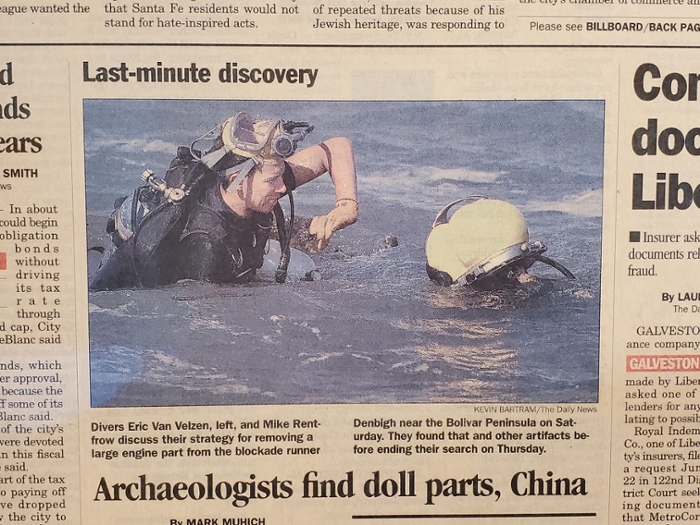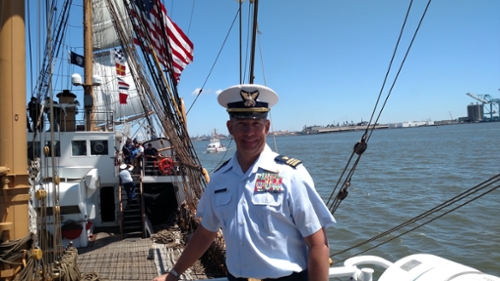A Life of Maritime Studies: CDR Eric VanVelzen '02
May 22, 2020
Tweet
By Andréa Bolt, Communications Specialist, Division of Marketing & Communications
Whether that meant as a diver exploring underwater archaeological sites, a lieutenant commander in the United States Coast Guard, onboard an eco-tour cruise ship in the South Pacific, a volunteer crewmember on the tall ship Elissa or as the Texas A&M Maritime Academy’s Commandant, he’s stayed true to his goal.
VanVelzen has led a life of adventure and service on his way to serve as commandant. It was important to him even at a young age to take advantage of new experiences and learning opportunities wherever he could find them, and being an Eagle Scout raised near the Puget Sound certainly helped shape him toward that end.
At the age of sixteen, VanVelzen earned his PADI Open Water SCUBA certification in the bone-chillingly cold waters off Alki Point in Seattle, Washington. This love of the maritime environment, and its incredible diversity, was the key to opening many doors during his lifetime.
After graduating high school, VanVelzen enlisted in the United States Marine Corps, where he served for seven years on active duty and an additional six years in the U.S. Marine Corps Reserve as an avionics technician, granting him the opportunity to fix electronics on McDonnell Douglas F/A-18 Hornets and travel the world.
While stationed in Hawaii, he took advantage of the easy access to scuba dive training and certifications. Today, he holds PADI Master Scuba Diver Trainer, IANTD Technical Deep Air, American Academy of Underwater Sciences Scientific Diver and Israeli Diving Federation Two-Star Diver certifications.
The story behind the Israeli dive certification is one that changed his life.
In the summer of 1996, VanVelzen heard about an underwater archaeology project at Caesarea Maritima in Israel. He signed up for the four-week field school, diving the Mediterranean waters of the ancient Roman harbor that historians have dated back to 22 BCE.
“I felt like this was my life’s calling and immediately thought, ‘How do I get more of this?’ As luck would have it, the usual dive master didn’t come that summer and there were many students who were scuba divers, but they didn’t have enough people with more extensive training and experience. So, I convinced them to keep me on as dive master four additional weeks and I returned two more summers after that as part of the staff,” VanVelzen recalled.
His time in the Marine Corps at an end, VanVelzen found himself at a community college in Southern California, but soon heard about a project with Texas A&M University’s Institute of Nautical Archaeology in Galveston called the Denbigh Project.
“I knew I wanted to dive on this project,” he said with determination.
VanVelzen made some calls, pulled the strings he could and found himself working on the project in the summer of 1999.

“The Denbigh was a Confederate blockade runner that ran aground trying to sneak past the Union blockade in May 1865 just offshore from the Bolivar lighthouse,” he explained. “It wasn’t necessarily a glamorous project, so I thought I had a good chance to get the job, and I did.”
During that summer in Galveston, VanVelzen learned about Texas A&M-Galveston’s new Maritime Studies (MAST) degree program and knew he’d found his home.
“I was hooked,” he said. “I loved the campus, Galveston, and transferred in as a student in the fall of ‘99 and started working as a deckhand in the small boat basin on campus.”
VanVelzen excelled inside and outside the classroom. Between volunteering on the Elissa, sailing with the Texas A&M-Galveston offshore racing team, and serving as student body president from 2001 - 2002, he’d decided to focus on pursuing a graduate degree at a university with “a great nautical archeology program.” He applied to and was accepted at Texas A&M, Eastern Carolina University and Florida State University.
But life had different water-based plans for him.
VanVelzen’s years as an avionics tech endeared him to Texas A&M-Galveston’s then-Head of Informational Services (IS), Steven Conway. Conway recruited VanVelzen from his student worker position in the small boat basin and convinced him to work for IS.
Conway, a retired United States Coast Guard Commander, also convinced VanVelzen that his time serving the country might not yet be done.
“He truly fed me the Coast Guard Kool-Aid,” VanVelzen says with a laugh. “But this was just after September 11 and the Coast Guard needed junior officers, so they opened up the aperture of how many officer candidates they were accepting.”
VanVelzen turned down his university acceptances and spent the next sixteen-and-a-half years in the Coast Guard.

He served aboard a Coast Guard cutter in Boston, worked port security in San Francisco and deployed to Kuwait, did a tour at the logistics headquarters in Virginia, worked with the U.S. Navy in the Western Pacific, served as the Logistics Department Head for U. S. Coast Guard Patrol Forces Southwest Asia in Bahrain, and more.
Finally, in September 2019, he decided his next calling was retirement.
“I was enjoying my retirement, taking my travel trailer and visiting as many U.S. National Parks as I could when I learned about the position for commandant come open. I put in my application, and they decided to take a chance on me.”
Looking back on his career and his decades spent on and near the water, VanVelzen is still quick to refer to himself as “mariner-adjacent.”
“I can handle myself at sea but I haven’t worked in a commercial capacity, and that’s a difference to note,” he emphasized. “I’m glad my title at the Texas A&M Maritime Academy is ‘commander,’ not to be confused with the university’s licensed captains, because the technical training and the responsibility they have is so intense. In my experiences working on a Coast Guard cutter and cruise ships, it's a different beast than working commercial seamanship and I’m very respectful of that fact.”
That said, VanVelzen reserves a special place in his soul for anything ocean-oriented. Galveston is a few thousand miles from the Puget Sound, and many thousands more away from Israel, but the siren call of the sea won’t be silenced for him anytime soon.
“Being on boats and on the water, you just get to experience things people on shore never do. Going across the North Atlantic in a storm is a humbling experience and makes you realize how small you are in this world. Some of my favorite places are the ones you can only get to by sea - such as Pitcairn Islands and Fatu Hiva in the Marquesas (Islands); they’re incredible.”
###
Media contact:Communications Specialist
a_bolt@tamug.edu
More:
Read more about Arts & Humanities
Read more about Health & Environment
Read more about Marine Sciences
Read more about Maritime Administration
Read more about Maritime Transportation
Read more about Texas A&M Maritime Academy